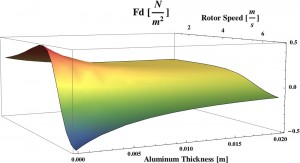Exploratory Design of Electromechanical Devices Using the Transfer Relations Theorem
Matthew Magill with adviser P. T. Krein

Figure 29: Force Density of 4-layer smooth-rotor induction machine over a range of rotor speeds and aluminum rotor coating thickness.
Our research goal is to establish an electromechanical design tool that aids in highlighting essential performance tradeoffs while encouraging exploratory geometries and designs. Numerical techniques, such as the finite element method and the boundary element method, yield extremely accurate determinations of field distributions within a given electromechanical arrangement, but this computational intensity often comes immense simulation times. A question then is: “Is the accuracy associated with numerical methods necessary, or even beneficial, when looking to gain intuition and understanding of trade-offs essential in the early stages of electromechanical system design?” This idea is explored using J. Melcher’s transfer relation theorem to estimate magnetic diffusion existing within a given device topology.
Uses for the magnetic transfer relation tool can be separated into two main categories: verification or optimization of predetermined device geometries, and exploratory device design through observing performance sensitivities. Example design strategies for an induction machine may involve selecting a baseline geometry and proceeding by viewing the performance sensitivities that result from varying material properties and thickness of the outermost rotor layer (Figure 29). The design approach may begin by forming a single rotor layer and traversing the material property space until desirable performance criteria are met. The result is a rotor comprised of a “metamaterial,” which may or may not be physically realizable. Using this solution method, the result is an extremely flexible tool capable of quickly highlighting trade-offs that are imperative in the electromechanical device design process.
This research is supported by the Grainger Center for Electric Machinery and Electromechanics.